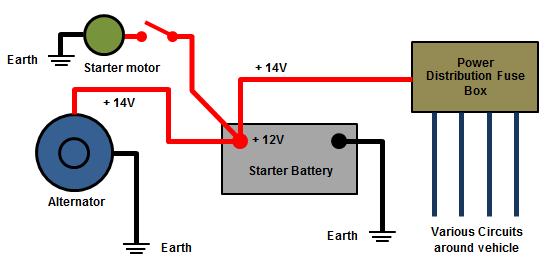Split Charging Guide
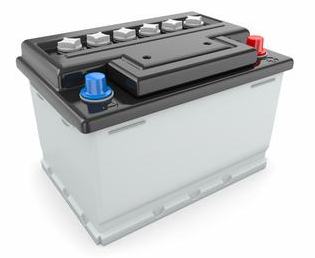 Overview
Overview
If you own a motorhome, campervan or boat then you'll almost certainly have electrically powered equipment installed that you'll want to run when your engine is off. These can be simple, low consumption items such as 12V sockets and LED lights through to more power hungry items such as a water pump, coolbox/fridge, navigation equipment, fan, laptop, TV or sound system.
If you try to power these from your engine starter battery without the engine running then before long you'll have flattened it, leaving you stranded. So the common solution is to fit one or more auxiliary batteries (often referred to as leisure batteries in vehicles or house batteries on boats) that are used purely to power those items not related to the starting of the engine. But once you have a second battery installed, how do you keep it charged up in the same way that the starter battery is? This is what split charging is all about and this article will give you an overview of the various technologies commonly used, as well a some pointers to consider when specifying your own system.
What is split charging?
Split charging is the term used to describe the simultaneous charging of the vehicle starter battery and the leisure battery (or batteries) from a common charging source. On vehicles and boats this charging source is almost always the vehicle alternator which is in turn powered by the engine, but there can also be other charging sources not related to the engine such as a mains powered charger, solar or wind powered re-charging systems and portable generators.
Modern split charge systems typically have a device that connects the starter and leisure batteries only when a charging source is operating, and electrically isolates them otherwise, ensuring that the use of one battery does not draw current from the other. It is important to ensure that the starter battery is isolated so the engine can always be started, but you also don't want the leisure battery to be accidentally drawn upon when starting the engine because dedicated leisure batteries are not designed for high current output over short periods of time and can be damaged.
A few words on battery charging
Before we look at connecting batteries for split charging, it's worth taking some time to understand how a battery obtains charge from the charging source.
12V batteries typically provide a voltage output in the region of 12-13V, depending on their level of charge, and when a charging source is attempting to deliver current to a battery to re-charge it, it must actually provide a voltage higher than that output by the battery in order for charge to flow into and be accumulated within the battery. It might be helpful to think of the voltages as acting in opposing directions with the voltage from the battery acting one way and the voltage from the charging source acting the other. Since a difference in voltage drives current flow (e.g. between +12V and 0V/ground), then with them each delivering identical voltages in opposing directions there is zero current flow. Only when the voltage of the charging source exceeds that of the battery will charge start to flow into the battery.
 |
For this reason alternators will typically deliver current to a battery at between 13.8 - 14.4V to enable them to start charging. A voltage regulator is fitted to the alternator to control the rate of charge and ensure that the upper voltage is limited and does not cause damage to the electrical systems.
It is also important to note that whilst an engine's alternator is supplying a voltage higher than that of the battery, all of the electrical systems are powered by the alternator, not by the battery. With the battery at a lower voltage than the charging source, no current can flow from the battery to the rest of the electrical system because current will be flowing into the battery. A typical charging system arrangement used in vehicles in shown in the diagram below:
Split charging methods/technologies
There are various split charge devices that can be fitted to allow charge to be distributed to both the starter and leisure batteries. The following is an overview of the various options along with the advantages and disadvantages of each (please note that if you have a vehicle with a 'smart' alternator then these methods will not be suitable and you will need to use a Battery-To-Battery charger instead):
| 1. Manual Switching |
| The most simple way to connect and disconnect the starter and leisure batteries is by using a battery isolation or master ON/OFF switch. This just uses a high current switch to manually connect the batteries in parallel once the engine is running and allow charge through to the leisure battery, and then disconnect them once the engine is turned off to isolate them and ensure the starter battery can't become flattened. |
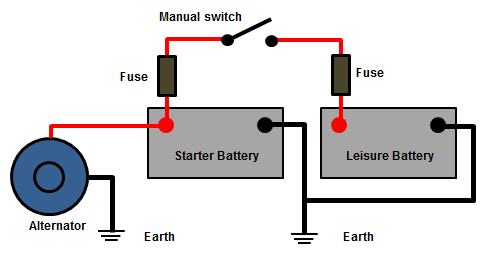 |
| Advantages | - Very inexpensive
- Simple
- Robust
- Batteries can be combined to start vehicle in an emergency (e.g. if starter is flat)
|
| Disadvantages | - Inconvenient
- Relies on user to manually connect and disconnect batteries
- Risks leaving batteries connected and flattening starter
|
| This is not a very 'smart' solution because it can be easily left on, flattening the starter battery. However on boats it is still quite common to have a multi-position rotary switches that can select either the starter battery, the leisure battery, or both and also dis-connect both of them from the charging system (sometimes referred to as a 1 / 2 / 1+2 / OFF switch). In addition to remembering to switch to house-batteries only when the engine is off (so as not to flatten the starter battery), care must be taken when using these types of switch as disconnecting all batteries from the alternator with the engine running can damage the alternator rectifying diodes (for the same reason you should never disconnect your car battery when the engine is running). |
| 2. Split Charge Relay |
| This system uses a heavy duty version of a simple 'make and break' relay, the coil of which is energised by a signal that is only +12V when the engine is running (usually the charge signal wire from the alternator). When energised, this relay connects the two batteries together and disconnects them when the engine is turned off (it is important that the relay closes only once the engine is running so that the leisure battery is not connected to the starter during engine cranking, so a switched ignition signal should not be used). A heavy duty version is required so that it can handle the potentially large current that could be passed through it by the charging source. |
| 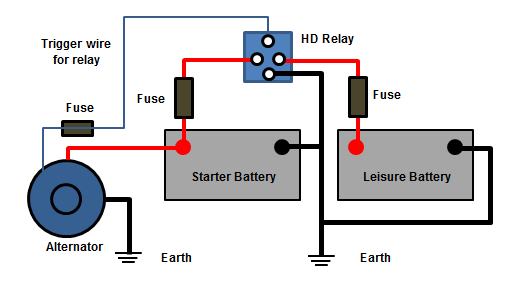
|
| Advantages | - Automatic operation
- Inexpensive
- Simple electro-mechanical construction
- Easily replaceable
|
| Disadvantages | - Requires connection to alternator or other part of vehicle electrical system which means tapping into factory wiring
- Moving contacts can wear out over time, leading to increased resistance and voltage drop
- Batteries cannot be combined for emergency engine start unless a bypass switch is fitted
- No 'intelligence' built into the relay
|
| This was the most common split charging solution before voltage sensitive relays became available, and is still sometimes used, however some are wary of tapping in to the vehicle electrical system in case of damage or problems with warranty issues and some more modern alternators are not compatible with these relays. |
| 3. Voltage Sensitive/Sensing Relay (VSR) |
| Voltage sensitive relays, or VSRs, sense the voltage of the starter battery and close the contacts inside the relay at a pre-set threshold, normally around 13.7V (check manufacture's specs). The contacts then open again at a pre-set lower threshold (normally around 12.8V). So when the alternator starts turning the voltage rises to around 14V at the starter battery terminals (assuming the battery is already well charged) and the relay will close to allow current through to charge the leisure battery. When the engine shuts off and the alternator stops turning, the voltage will gradually drop away at the starter battery terminals and the relay will open again, isolating the batteries once more. For more information on how to make a split charge kit with a voltage sensitive relay, check out our YouTube Video  |
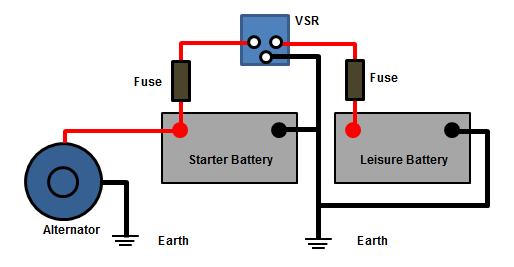 |
| Advantages | - Automatic operation
- Relatively inexpensive
- Simple to install (no need to modify factory-fitted electrical system - no warranty issues)
- Are generally dual sensing, meaning that they operate when sensing a voltage rise on either side of the relay. This means that the starter battery will also charge when the leisure battery is being charged by a mains battery charger by solar power or other charging source.
- Some models have an emergency engine start feature to combine the batteries
|
| Disadvantages | - Moving contacts can wear out over time, leading to increased resistance and voltage drop
|
| These types of split charge device are probably the most popular on the market for smaller applications with a single leisure battery (typically up to around 150Ah) such as found in campervan conversions, 4x4s, smaller motorhomes etc. They are relatively inexpensive, simple to fit and reliable. Some of the more intelligent VSRs have voltage trending software built-in to monitor voltage over time and determine if and when to open/close the relay based upon the trend, rather than using fixed lower and upper voltage thresholds. This is useful to eliminate unwanted opening and closing of the relay due to momentary voltage fluctuations. |
| 4. Battery Isolator / Charge Splitter |
| This split charging method utilises the property of diodes to allow current to flow only in one direction. So current can flow from the alternator (or other charging source, e.g. battery charger) to both batteries but cannot flow between batteries, thereby isolating the starter battery from the leisure battery and preventing it being flattened. The biggest drawback with the use of diodes is that they incur a relatively large voltage drop across them, typically around 1V, which in a 12V system is quite significant. This voltage drop means that the leisure battery never sees the maximum voltage from the alternator and doesn't fully charge, so split charge diodes are sometimes used in conjunction with an after-market alternator controller to increase the regulated output voltage and compensate for the voltage drop. |
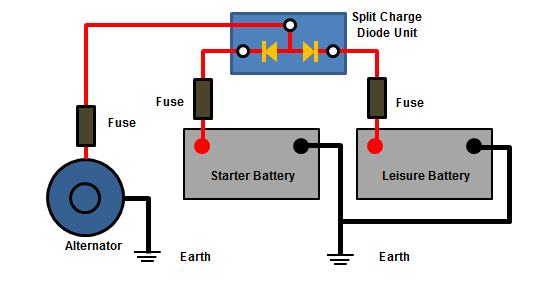 |
| Advantages | - Automatic operation
- No contacts to wear out
- Simple to install
- Units often have multiple outputs for several batteries
- No risk of contacts arcing and so protects against ignition (important on boats where gas or petrol fume build up is a concern)
|
| Disadvantages | - Suffer voltage drop so don't charge batteries fully
- May need to be used with after-market alternator regulator to boost voltage
- Generate significant amounts of heat
- Batteries cannot be combined for emergency engine start unless a bypass switch is fitted
- Relatively expensive
|
| Split charge diodes are still widely used in the marine sector due to their simplicity and durability which offsets their slightly lower charging performance compared with other systems. Manufacturers have also started to employ new technologies to minimise the voltage drop issues such as the use of low-voltage drop Schottky diodes and FET-based charge splitting. |
Design considerations for a split charging system
The following are a few points to consider when designing your split charge system. Please note that every installation will differ slightly so this is intended as a guide only.
| The complexity of your leisure/auxiliary electrical system If you have a relatively simple electrical system consisting of a single battery with a few consumers, e.g. lights, fridge/coolbox, water pump, power sockets etc. then a VSR is probably the best option. Example installations would be campervans, small motorhomes and horseboxes, small commercial vehicles small day/fishing boats. If you have a complex electrical system with multiple batteries, several electrical sub-systems and many consumers then one or more battery isolators is probably the best option. Example installations would be large motorhomes and horseboxes, larger sailing/motor boats or commercial vessels and heavy commercial vehicles. IMPORTANT: If you have a vehicle with a 'smart' alternator (as a rule of thumb this applies to vehicles with Euro 5 or 6 compliant engines onwards) the split charging methods outlined above won't be suitable and you'll need to use a Battery-To-Battery charger instead. Find out more info by reading our Knowledge Centre article and discover the benefits of using a battery-to-battery charger over split charge systems. |
| Sizing your split charge unit and connecting cables When a battery is deeply discharged it has a very low resistance and so will draw a large current from any charging source attached. For this reason the cables used to connect the batteries and the split charge unit itself should rated to handle the maximum current that the charging source is capable of supplying to ensure that they are not damaged. For any reasonable sized alternator this means using battery cable of at least 16mm² cross-section (110A) and upwards, depending on the application and cable run length. The same applies for the split charging device itself; it should be rated high enough so that is is not damaged if the leisure battery (or batteries) is deeply discharged and draws a very high current from the alternator. It's also worth considering that in a split charging system the connected starter battery is also effectively a charging source that will try to equalise the voltage in the leisure battery when they are connected, so if your leisure battery is drained to a very low level you could see a combined current from the alternator and the starter battery for a short period of time which might be larger than the alternator could supply on its own. Allowing a battery to become too deeply discharged is damaging and you can prevent this using a battery guard. There are many commercially available split charge kits featuring relays and cable that are not rated high enough for the maximum alternator output of the vehicle in which they'll be installed. Whilst this will not be a problem if the system is fused properly, it does mean that you could easily keep blowing fuses if your battery is deeply discharged and a large current is drawn from the charging source. An annoyance at best and extremely inconvenient at worst. We would advise against using any system that is not capable of handling the maximum output of your charging source. For more information on choosing the correct cable please take a look at our Cable Sizing & Selection guide. |
| Balancing your split charging system If you intend to charge multiple connected leisure batteries at the same time (i.e. a bank of connected batteries used to increase total capacity) then to ensure that all batteries are charged equally and that one does not get prioritised over the other it is good practice to design your system as follows: - If there are multiple cables running from the split charging device to each of the batteries then they should be of equal size and length and as short as possible.
- Similarly, the earth cables running from each battery should be of equal size and length and as short as possible.
- Battery-battery connecting cables in a battery bank should be as short as possible
- The batteries should be of the same type, size and age (batteries lose charge holding ability with age)
- The batteries should be discharged equally so that they 'age' at the same rate
These are not always practical in a real-World installation but will give your batteries the best chance of lasting for the same amount of time. Some of the more advanced charging systems can overcome differences in battery health and monitor usage to optimise charging for each battery, so the above becomes less critical. |
| Protecting your split charge circuit Whatever split charge system you opt for, the most important aspect is to ensure that all connecting cables are protected by appropriately rated fuses to prevent an electrical fire. Each battery that connects into the split charge device should have an appropriately rated fuse installed in-line with the cable, as close as possible to its +ve terminal. This minimises the unprotected length of cable (the section from the terminal to the fuse) and the associated risk of an accidental short circuit due to, for example, mechanical abrasion, vibration damage or termination failure. It is also a good idea to install manual battery isolation switches to totally disconnect the batteries from the charging sources in the event of an emergency, or simply for convenience when carrying our work on or around the batteries. For more information on fusing please take a look at our Fusing Guide. |
| Combining batteries in an emergency Although split charge systems are designed to keep the starter and leisure batteries separated when the engine is not running, there might be emergency circumstances where you want to intentionally join them , for example if the starter battery fails and you need to start the engine from the leisure battery or if your leisure battery fails and you need to run some emergency lighting or safety-critical equipment (e.g. VHF) from your starter battery. If your split charge device does not already have this facility then you might want to consider adding a manual battery switch to the circuit to by-pass the split charge device. Note: Care should be taken if using this feature for engine starting as starter motors can draw very high currents, so the switch should be rated sufficiently. Although some VSRs have this emergency override facility built-in, the high currents drawn by a start motor could weld the contacts together and render it useless, so it might be prudent to use a manual by-pass switch anyway and avoid the risk of damage. |


 Overview
Overview
